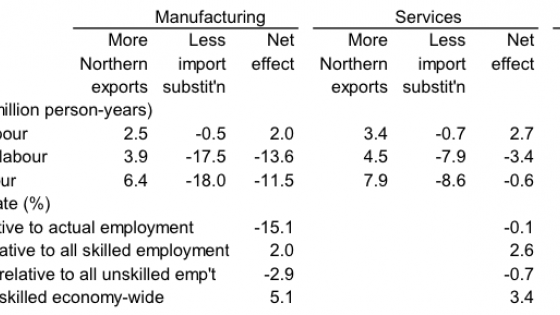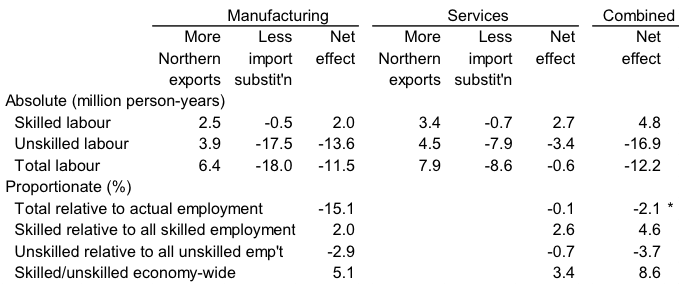Some people, economists included (for example, Colantone and Stanig 2017), attribute recent populist upheavals – Brexit, Trump, Le Pen, AfD – to the harm that globalisation has inflicted on workers in developed countries. Other economists (Helpman 2017 is one of them) reject this claim. These events have revived a debate among economists that occurred – and apparently was settled – 20 years ago. Did the economics profession get it wrong in the 1990s? I address that question in a new paper (Wood 2018).
The 1990s debate
Some economists explained declining relative demand during the 1980s for less-skilled workers in most developed countries using Heckscher-Ohlin (HO) trade theory. They attributed the decline to reduced barriers to developed-developing country (North-South) trade in manufactures (Leamer 1993 and Wood 1994). Other trade economists and labour economists contested this conclusion. Instead, they emphasised the role of technology, including the diffusion of computers (Krueger 1993). The conflicting views stimulated a flood of further economic analysis (surveyed by Cline 1997 and Feenstra and Hanson 2001).
By the year 2000, the debate was over. Most economists joined a consensus that the main explanation was skill-biased technological change. This consensus was not primarily shaped by direct evidence of the effects of new technology. Economists instead doubted the trade explanation: whether trade with the south was big enough to account for the labour market outcomes, and whether movements in goods prices, intra-sectoral skill intensities, and relative wages in the south fitted the HO story (Krugman and Obstfeld 2006, Autor et al. 2016, Pavcnik 2017).
The 1990s debate had an enduring success by launching a new field of economic research.1 Economists on both sides of the debate, however, had an incomplete understanding of the impact of globalisation. Because there was so much more to learn, from an academic perspective the debate ended prematurely.
In hindsight, researchers were blinkered by HO theory. Not enough attention was paid to other mechanisms by which trade might affect wages. HO also assumes that labour mobility within countries is costless, and this unfortunately caused economists to forget that particular localities often bear most of the social costs of expansion of trade (Autor et al. 2016).
Subsequent evidence
Since the 1990s, the economic position of less-educated people in developed countries has continued to deteriorate. This has occurred in more dimensions than were considered in the debate, which focused on relative wages. The total income share of the top 1% has risen dramatically, labour’s share of GDP has fallen, employment opportunities in manufacturing have shrunk further, casual contracts have replaced regular jobs, and ‘deaths of despair’ have multiplied.
Now we are debating again how much globalisation has contributed to this deterioration. The official view of international organisations, shared by many academic economists, is that globalisation played a minor role. They argue that less-skilled workers have suffered mainly from technological progress and rising productivity (IMF-WB-WTO 2016, OECD 2017, Helpman 2017). But, as in the 1990s, there is a shortage of evidence for this position.
Table 1 Impact of North-South non-primary trade on demand for labour in the North, 2011
Source: Wood (2018).
In my paper I calculate factor content (for 2011) of trade estimates of the impact on labour demand in the North (all OECD countries) of exports of manufactures and services from the South (all non-OECD countries). Table 1 shows the base case. Imports from the South reduce demand for labour in manufacturing by 18 million jobs, roughly consistent with the widely-cited estimate of Acemoglu et al. (2016) for the US and China alone. The counterpart increase in Northern manufactured exports to the South generate an offset of just 6 million jobs, because the items exported are less labour-intensive than the imports.2
Though Southern non-primary exports reduce the total demand for labour in manufacturing and services by only 2% of economy-wide employment, they have a bigger effect on its skill composition. The demand for skilled (college-educated) labour, relative to unskilled labour, is increased in both manufacturing and services, raising the economy-wide relative demand for skilled labour by 9%. This rise becomes larger if the definition of ‘skilled’ is widened to include completed secondary schooling, or if the definition of ‘North’ is narrowed to OECD countries as of 1990.
The estimated reduction in manufacturing employment of about 12 million compares with an actual fall in OECD countries, between 1985 and 2014, of 18 million. Two-thirds of this fall occurred after 2000, when China’s exports boomed, consistent with the influence of north-south trade. But the estimated trade-induced increase in relative demand for college graduates was less than half of the actual increase. Most of this occurred before 2000, unlike the time path of north-south trade.
These factor content calculations show that increased trade with the South had substantial effects on labour markets in the North. They do not explain much of the deterioration in the situation of less-skilled workers in the North, but they also omit many channels through which globalisation could have this impact.
One important channel would be labour-displacing improvements in technology stimulated by trade, as suggested by the empirical results of Bloom et al. (2016), and Pierce and Schott (2016). Another is the offshoring of northern technology in manufacturing and services, which not only contributed greatly to growth of exports from the South to the North (Baldwin 2016), but also enriched the Northern owners of the technology. In this way, it contributed to the rise in the share of the top 1%, and the fall in the share of labour in the North.3
Although there were surely other causes of the long deterioration in the economic position of ordinary people in the North, we cannot be confident that globalisation made a minor contribution. Given the state of the evidence, a more tenable position would be that we don’t know how big the contribution has been.
Were policymakers misled?
The trade and wages debate of the 1990s was the first stage of a much larger academic research programme. But, more important, did the economic consensus that emerged from that debate help or harm at a practical level?
We can argue that the outcome did not matter. The protagonists, though they disagreed about causes, largely agreed about policy responses. These were to increase the supply of skilled workers, stimulate demand for unskilled workers, and redistribute from gainers to losers. All these policy responses, moreover, would have required higher taxes on the gainers. This did not have sufficient political support.
Policymakers took some steps in the right direction, such as the Earned Income Tax Credit in the US. But as recent political events confirm, not nearly enough was done to address the well-founded concerns of many ordinary people that they were being left behind economically and socially.
Would more had been done if there had been a different outcome to the debate in the 1990s? In this case, the answer is probably ‘yes’. The actual outcome created unwarranted complacency about the social costs of globalisation. This does not depend on believing that globalisation was the main cause of the problems of the less-skilled, either in the 1990s or afterwards. It depends only on believing that globalisation had significant adverse social effects. This is now almost universally acknowledged (IMF-WB-WTO 2016).
The economic consensus that globalisation was not the main cause of increasing inequality in the north encouraged policymakers to tune out. It undermined the argument for using a crucial political lever for action, namely fear of protectionism. It was comforting to believe that the problems of the unskilled were caused by new technology, because there was no risk of neo-Luddites smashing computers. If policymakers and self-interested gainers had recognised the risk of a powerful political backlash against globalisation, it might have attracted their attention. Eventually it did, too late, in 2016 and 2017.
The result of a different outcome to the debate of the 1990s would probably have been better policies, but those policies might not have been effective enough to avoid the current social and political problems in developed countries. The future policy challenge in these countries remains basically the same as it was in the 1990s. Whatever the causes of aggregate economic progress, policymakers must find ways to spread the gains from that progress that will work both economically and politically.
References
Acemoglu, D, D Autor, D Dorn, G Hanson and B Price (2016), “Import Competition and the Great U.S. Employment Sag of the 2000s”, Journal of Labor Economics 34(S1): S141-S198.
Autor, D, D Dorn and G Hanson (2016), “The China Shock: Learning from Labor Market Adjustment to Large Changes in Trade”, Annual Review of Economics 8(1): 205-40.
Baldwin, R (2016), The Great Convergence: Information Technology and the New Globalisation, Harvard University Press.
Bloom, N, M Draca, and J Van Reenen (2016), “Trade Induced Technical Change? The Impact of Chinese Imports on Innovation, IT, and Productivity”, Review of Economic Studies 83(1): 87-117.
Cline, W (1997), Trade and Income Distribution, Institute for International Economics.
Colantone, I, and P Stanig (2017), “The Trade Origins of Economic Nationalism: Import Competition and Voting Behavior in Western Europe”, BAFFI CAREFIN Centre research paper 2017-49.
Feenstra, R and G Hanson (2001), “Global Production and Inequality: A Survey of Trade and Wages”, NBER working paper 8372. Published in 2003 in J Harrigan (ed.), Handbook of International Trade, Blackwell.
Feenstra, R, H Ma, A Sasahara and Y Xu (2018), “Reconsidering the ‘China shock’ in trade”, VoxEu.org, 18 January.
Helpman, E (2017), “Globalisation and Wage Inequality”, Journal of the British Academy 5: 125-62.
IMF-WB-WTO (2016), Making Trade an Engine of Growth for All: The Case for Trade and for Policies to Facilitate Adjustment, International Monetary Fund, World Bank and World Trade Organisation.
Krueger, A (1993), “How Computers Have Changed the Wage Structure: Evidence from Microdata 1984–89”, Quarterly Journal of Economics 108(1): 33–60.
Krugman, P and M Obstfeld (2006), International Economics: Theory and Policy, 7th edn. (Boston: Addison Wesley).
Leamer, E (1993), “Wage Effects of a U.S.-Mexican Free Trade Agreement”, in P Garber (ed.), The Mexico-U.S. Free Trade Agreement, MIT Press.
OECD (2017), Employment Outlook 2017.
Pavcnik, N (2017), “The Impact of Trade on Inequality in Developing Countries”, CEPR Discussion Paper 12331.
Pierce, J, and P Schott (2016), “The Surprisingly Swift Decline of US Manufacturing Employment”, American Economic Review 106(7): 1632-62.
Wood, A (1994), North-South Trade, Employment and Inequality: Changing Fortunes in a Skill-Driven World, Oxford University Press.
Wood, A (2018), “The 1990s Trade and Wages Debate in Retrospect”, The World Economy 41(4): 975-99.
Endnotes
[1] EconLit records about 1,000 books and 2,400 journal articles using the F16 JEL trade and wages classification created during the debate.
[2] Feenstra et al. (2018) arrive at less negative results for US manufacturing employment by comparing the effects of imports from China with those of exports to all destinations.
[3] Increased immigration, popularly seen as another major channel, probably made a relatively small contribution. Restrictions on the international movement of people remained far tighter than on the movement of goods, services, capital and technology.



